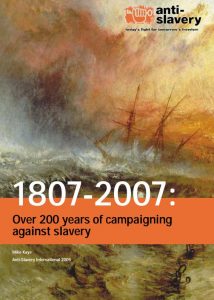Resource Title
1807-2007: Over 200 years of campaigning against slavery
Summary
Anti-Slavery International produced this report as part of its campaign to use the 200th anniversary of the end of the slave trade in the British colonies to raise awareness of both historical and contemporary forms of slavery.
This publication gives an overview of the Transatlantic Slave Trade and considers the factors that, in less than twenty years, led isolated voices of protest to develop into a popular movement, which helped bring about the abolition of the slave trade in 1807.
Resource Details
Description
‘The report also traces how, after the end of the Transatlantic Slave Trade, new forms of slavery began to manifest themselves and how these contemporary forms of slavery were challenged through popular campaigns and by the development of international standards to prohibit them. It also considers what action needs to be taken to assist the millions of people who continue to be subjected to contemporary forms of slavery today.
Anti-Slavery International hopes this publication will revitalise the abolitionist spirit which helped to end the Transatlantic Slave Trade and inspire people to support our campaigning work against all contemporary forms of slavery.’
Contents
The Transatlantic Slave Trade
- People as property: the human cost
- The slave trade: “a creditable way of life”
- Turning the tide: making the slave trade an issue of public concern
- A sea change: the St Domingue Rebellion
- The demise of the Transatlantic Slave Trade
Out of the ashes: new manifestations of slavery in the 19th and 20th centuries
- Coolie labour in the British colonies
- Forced labour in the Congo
- Forced labour in the Amazon: the Putumayo
- The use of forced labour by the colonial powers
Contemporary forms of slavery
- The development of international standards to prohibit all forms of slavery
- Slavery in the 21st century
- What needs to be done to eradicate slavery today?
Conclusion
Available from:
Download 1807-2007: Over 200 years of campaigning against slavery PDF (1.22MB)
For more, visit www.antislavery.org

